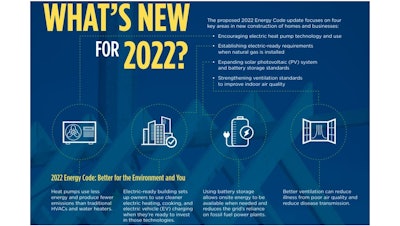
On Wednesday the California Energy Commission voted unanimously to approve the 2022 Building Energy Efficiency Standards that will require builders to include solar power and battery storage in many new and renovated commercial structures as well as high-rise residential projects. The energy plan also calls for new homes to be wired in ways that ease and encourage conversion of natural-gas heating and appliances to electric sources.
As the state's primary energy policy and planning agency, the CEC adopts standards every three years to cost-effectively increase energy efficiency and reduce the carbon footprint of buildings. Homes and businesses use nearly 70% of California’s electricity and are responsible for a quarter of the state’s greenhouse gas emissions.
The 2022 update will be submitted to the California Building Standards Commission, which is scheduled to consider it in December 2021. If approved, it would go into effect on January 1, 2023. The New York Times reports that Lindsay Buckley, a spokeswoman for the Energy Commission, said that “while there is no guarantee” that the Building Standards Commission will adopt the plan, it had never rejected such a proposal after approval by the energy panel.
Commercial buildings that would be affected by the plan include hotels, offices, medical offices and clinics, retail and grocery stores, restaurants, schools, and civic spaces like theaters, auditoriums and convention centers.
The provisions would supplement requirements that took effect last year mandating that new single-family homes and multifamily dwellings up to three stories high include solar power.
The CEC focused on four key areas and their benefits in drafting the 2022 Energy Code for newly constructed homes and businesses:
- Encouraging electric heat pump technology for space and water heating, which consumes less energy and produces fewer emissions than gas-powered units.
- Establishing electric-ready requirements for single-family homes to position owners to use cleaner electric heating, cooking and electric vehicle charging options whenever they choose to adopt those technologies.
- Expanding solar photovoltaic system and battery storage standards to make clean energy available onsite and complement the state’s progress toward a 100% clean electricity grid.
- Strengthening ventilation standards to improve indoor air quality.
Over the next 30 years, the 2022 Energy Code is estimated to provide $1.5 billion in consumer benefits and reduce 10 million metric tons of GHGs, equivalent to taking nearly 2.2 million cars off the road for a year.
“The 2022 Energy Code firmly pivots California’s buildings toward the clean, low-carbon technologies that are the bedrock on which our collective path forward will rest,” said Commissioner J. Andrew McAllister, who is the lead commissioner on energy efficiency. “This foundation will help the state meet its critical long-term climate and carbon neutrality goals.”
The CEC’s statement on the 2022 Energy Code says, “The impact of climate change is accelerating, bringing an even greater need for buildings that are comfortable, efficient and resilient. Each updated code guides the construction of buildings to better withstand extreme weather, lower energy costs and reduce climate and air pollution.”



















